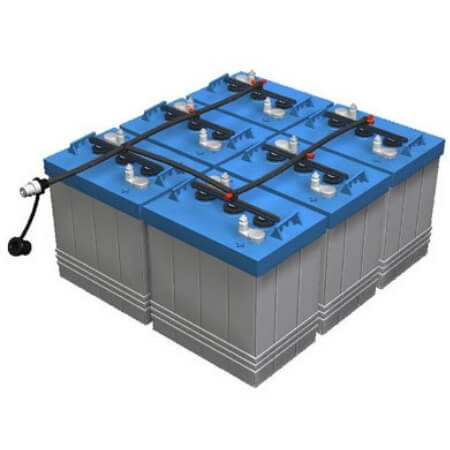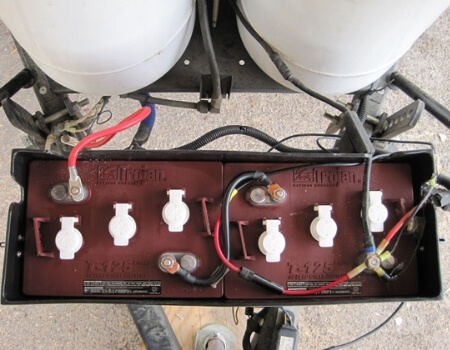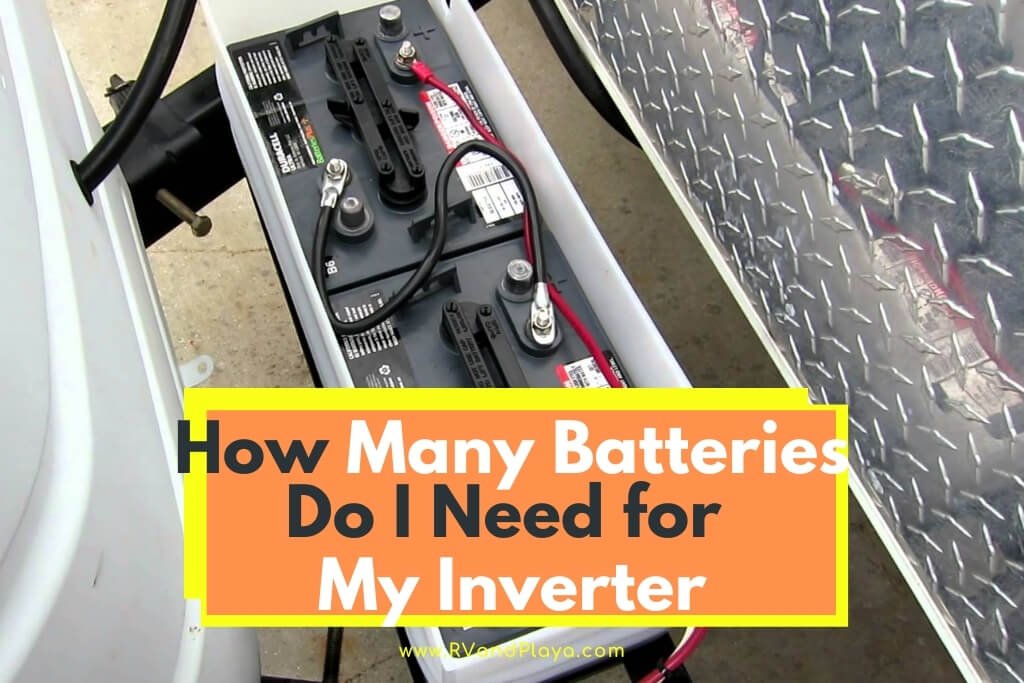RV and camper upkeep can be a challenge, as there’s a lot of uncertainty surrounding how best to power your RV or camper. When getting the power set up in your vehicle, one of the most important things to know is how many batteries you’ll need for your RV’s inverter.
I’ve researched this topic and will tell you all you need to know.
How many batteries do I need for my inverter? The calculation for figuring out how many batteries you need for your inverter is (Total Hours Needed Continuously X Watts)/DC volts = Amps Needed. After this calculation is done, divide the amps you require by the amps allowed by the batteries to find out the number of batteries you need.
To learn more about calculating your battery needs, as well as exciting tips about powering your RV or camper, keep on reading!
Table of Contents
Calculating How Many Batteries You Need
The equation for finding out how much battery power you need can be confusing, so read the detailed outline below for in-depth steps to work the equation.

Calculate your daily power consumption in watt-hours.
This will require taking a look at the tag on each of your appliances and record the watt-hours from each.
You’ll then add up all of the wattages for each appliance and then write down that number.
Related reading: Is it Bad to Leave Your RV Plugged in all the time?
Determine how many hours you want to use your appliances.
This step requires you to think about how much time you will be using your appliances.
It is wise to overestimate the hours of use you want. You never know if you may need to use one or more appliances for longer than you initially thought you would.
Multiple your necessary hours by the watt-hours that you added up in the first step. Write down the number you get after multiplying the hours by the watt-hours.
Related reading: Can a TV Run on a 12V Battery? [This Is How]
Divide the result from the second step by your battery’s number of volts.
In this final step, you will take the result of the previous step and divide it by the number of volts on the battery that you will be using.
This calculation will give you the number of amps you need to power. Then you’ll know how many batteries you need.
Read on to the next section to find out how to turn the number of amps into the number of batteries you need to supply those amps.
Example Calculation
Let’s say you need 5 hours of total run time for appliances totaling 1000 watts, and you have 12 DC volts.
The calculation would look like this:
(5 x 1000)/12 = 417 amps
You would need a total of 417 amps of stored power in your batteries to keep everything running.
It is not recommended to use up your batteries fully, so keep this in mind when you are calculating the number of batteries needed.
Related reading: This Is What Happens to Solar Power When Batteries Are Full? – (FACTS)
How Many Batteries Do I Need?
To determine how many batteries you need, it’s essential to know what type of battery you have.
Different battery types deliver different levels of amps (AH). To quickly find out how many batteries you need, you’ll need to divide the total number of amps you need by the number of amps the battery delivers.
How to Calculate the Number of Batteries
There’s a simple equation to help you calculate how many batteries you’ll need. Plug the numbers into this formula:
Amps needed / amp allowance = number of batteries
For instance, one 12-volt 24 group battery can deliver 70 to 85 AH. If you wire two 12 volts 24 group batteries in parallel, they will keep the same voltage and double your AH to 140-170.
Using the example from above, where 417 AH is needed, you would need a minimum of six 12 volts 24 group batteries to fulfill the power requirements for your RV.
417/70 = 5.95 (round up to 6 batteries)
Unlike non-RV people, RVers often use larger 6-volt golf cart batteries. Because you need to double the voltage to suit your RVs 12-volt system, golf cart batteries need to be paired and wired up in series.
A pair of 6-volt batteries typically delivers 180 to 220 AH.
Doubling back to the example in the previous section, if your power requirement is 417 AH, you will need a minimum of 5 batteries.
417/90 = 4.63 (round up to 5 batteries)
To store even more significant amounts of current, you can build bigger battery banks by wiring in both series and parallel.
Four golf cart batteries wired up correctly will deliver 12 volts and 360 to 440 AH. Doubling back to the example in the previous section, if your power requirement is 417 AH, you will need a minimum of 5 batteries.
417/90 = (round up to 5 batteries)
Below you’ll find a table showing how many batteries you’ll need for varying amounts of watts and amps:
| WATTS | Number of Amps Required | Number of 12 Volt 24 Group BATTERIES Needed (70 AH output) |
|---|---|---|
| 250 | 200 | 3 |
| 750 | 300 | 5 |
| 1000 | 400 | 6 |
| 1250 | 500 | 8 |
| 2500 | 1000 | 15 |
| 5000 | 2000 | 29 |
| 6250 | 2500 | 36 |
| 12500 | 5000 | 72 |
Tips for Buying Batteries for Your RV or Camper
Buying the right batteries is just as important as having the correct number. Here are some tips you can refer to when buying your batteries for your RV.
- A battery monitoring system can execute all of these calculations for you-no pen, paper, or calculator needed. And while battery monitoring systems can be pricey, they could certainly be worth the money. They show you exactly how much power each of your appliances is using.
2. The calculations that you make to determine how many batteries you need are not exact, as it is based on how much power you think you will consume within 24 hours. If you aren’t aware of your power usage, it’s possible that you could either overestimate or underestimate your power needs.

3. When calculating how many batteries you need, round up. You may have noticed in the previous section that all of the numbers are using the rounded up. This is because a little extra battery power won’t hurt, and rounding up will help to ensure that you won’t be short on power.
4. Always purchase a spare battery or two. There is always a chance that your battery can suddenly stop working correctly, and you don’t want to be without adequate power while out on the road.
5. If you find that you need a more robust power source than you initially thought, look into used batteries. You may be able to find a series of batteries at a low price.
How Many Batteries Do I Need for 1000 Watts?
Many RVers ask questions like “How many batteries do I need for 1000 Watts, 2000 watts, 3000 Watts, etc. Unfortunately, these questions can’t be answered without additional information, including:
- What is the DC input voltage of your inverter?
- What is the average load that you will be applying to the output?
- How many hours between recharges?
The answer to the question of how many batteries are needed depends on how long you want to operate the inverter at that load and, ultimately, how many amps you need to support.
The only way to know for sure how many batteries you need is to go through the calculations outlined in this article.
If you don’t tailor the equations to your needs, you will be essentially guessing, and this could backfire with you either overpaying on too many batteries or needing more batteries.
How Long Will a 12v Battery Last With An Inverter?
Before calculating how long a 12v battery will last with an inverter, you will need to know your battery’s capacity and its type. You would then need to find out how many amp-hours the battery has.
How long will a 12v battery last with an inverter? A typical car battery with a 12v rating has an estimated 48 Ah capacity when fully charged, which means that it can deliver one amp for 48hrs, 2 for 24hrs, and so on.
Because no battery runs on 100% efficiency, you should always factor in 10-20% power loss.
So if your car battery was 65 watts at 80% energy and your inverter was 72 watts, you would calculate your amps as following:
- 72 watts / 12 volts = 6 amps.
- If your car battery delivers 60 amps per hour, your battery will last 10 hours (taking into account how much residual power should remain ion your battery according to battery type.)
Another way to calculate your 12 Volt battery run time is to use this formula:
- (10 x (Battery Capacity in Amp Hours) / (Load Power in Watts)) / 2 = Run Time in Hours
What Is The Best Battery For an Inverter?
Deep cycle (marine or RV) batteries are more costly but they give you hundreds of charge/discharge cycles, so you get a greater lifespan out of your battery. The deep cycle battery is designed to deliver continuous current over time, unlike regular vehicle starting batteries.
They deliver higher peak amps than conventional batteries and last at least twice as long. They provide a more consistent voltage across the discharge curve and perform better in hot and cold conditions than traditional batteries.
Although lead-acid batteries are a common choice for inverters, they only last 3-4 years and require regular maintenance. This maintenance involves electrolyte level checks and topping up.
Because they release gasses during charging and operation, they need to be well ventilated. Sealed lead-acid batteries are also a common choice, but they are costly and have a shorter lifespan than the deep cycle batteries.
How Long Does It Take a 100-watt Solar Panel To Charge a 12-volt Battery?
If you use the rule of thumb that you shouldn’t let your battery go below 50% capacity, you would need to charge 50Ah at 12 volts, which is 600Wh.
Because no solar panel will ever operate at 100 percent capacity, you should allow a 25% energy loss leeway.
However, if your panel system were running at 100%, it would take (600wh x 2)/100W= 12 hours of charge to charge the battery from 50%-100%.
How long does it take a 100-watt solar panel to charge a 12-volt battery? On average, you will probably need closer to 15 hours, given the inherent variables in the equation.
Can I Run 2 Inverters off 1 Battery?
Can I run 2 inverters off 2 battery? Yes, you can run two inverters off one battery if your inverters are compatible to be stacked into parallel formation. Ensure that you consult your manufacturer’s guide to ascertain that your inverter can be stacked.
Chose two identical power inverters to ensure compatibility and be aware that you will be doubling your amperage draw from your batteries.
Ensure your input wires are less than 6 feet long and that your power inverters are stored next to the power source. Your power source will determine the size of your wires in terms of voltage and maximum amperage.
The second inverter or slave inverter should be connected to the first (master) inverter by connecting the second inverters positive input into the positive output of the master inverter (repeat with the negative slave input to the negative master output.)
Does An Inverter Use Power If Nothing Is Plugged In?
Does an inverter use power if nothing is plugged in? Yes, your inverter will draw power even if there is no power load of appliances being run. Modern inverters are made to draw 8-10 percent more energy than they need when in operation.
The precise amount of DC amps you will use is to divide the AC wattage of your appliance by 12 (if running from a 12-volt battery) and multiply the total by 1.1.
Inverters will still draw from your battery when not in use and if the unit is turned on. This draw amount can vary from 0.2 amps to 2.0 amps depending on your unit so that you would lose an average of 1 amp per hour.
Final Thoughts
Now you can purchase the appropriate type and number of batteries for your RV and Camper needs.
You know precisely how to calculate the amps you need and how to figure out how many batteries you need to fulfill your power requirements.
Sources
https://www.google.com/amp/s/www.rvwithtito.com/articles/battery-capacity/amp/
https://www.altestore.com/howto/recommended-inverter-cables-sizing-and-breakers-or-fuses-a62/
https://www.donrowe.com/power-inverter-faq-a/258.htm
Recommended Reading
For more helpful articles about Inverter please check out our articles below:
What is an Inverter in an RV and Why Do You Need it?
This Is Why Your RV Inverter Is Beeping [Facts You Should Know]
Does Your Travel Trailer Have an Inverter? Here’s How to Check
What is a Non-ducted RV Air Conditioner? (Ducted vs. Non-ducted)
Recent Posts
Is Toyota Remote Connect Free? (Subscription, Services Plans)
Does Toyota Remote Connect have an included trial? It used to be the case that, when you bought a new car, you made one straightforward payment and that was it. Now, it feels like there are...
Toyota Safety Connect: What It Is And Why You Need It? Whether you’re buying a new Toyota or you’ve had one for a while you will have been given the hard sell on their Connected Services but do...

